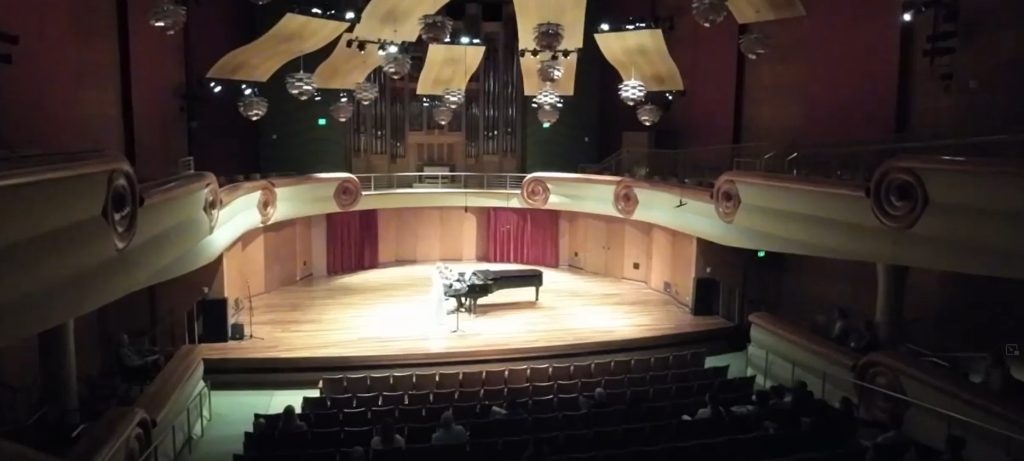The 47th International Viola Congress takes place in Columbus, Georgia (USA) from June 1st – 5th, 2022. This daily blog / report is delivered to you by DVS board member Emlyn Stam.
Day 1: Wednesday, June 1st, 2022
<next day>
This year’s International Viola Congress is happening in the small town of Columbus, Georgia, USA. It’s been almost 3 years since the previous IVC (in Poznan, Poland), but more importantly, for the first time since 2012, the congress is once again organized in the United States, in conjunction with the American Viola Society’s annual festival.
Columbus is a quiet town with a distinctly southern atmosphere on the Alabama border. Houses with white columns and front porches with rocking chairs and friendly, southern hospitality. People routinely greet you when you pass them on the street. The various churches clearly play a big role in the community. It is also notable for those of us coming from abroad that numerous people on the street openly carry firearms. I also overheard one spirited discussion about politics in America at a local café.
The congress is taking place at the Columbus University’s Schwob School of Music and is hosted by the viola professor Dr. Katrin Meidell and her amicable team. The distinguished violist Manuel Diaz, her predecessor who is nearly 90 years old, was given an AVS award at the opening ceremony. He told the audience his incredible life story from his family’s flight during the Spanish Civil War to their arrival in Chile as refugees in the 1930s. In Chile, Diaz took up the viola and became the principal of the national orchestra. Eventually the coup in Chile forced Diaz to flee to the United States with his family where he in turn worked at the Atlanta Symphony and for a firm as an engineer before he was able to take up a professorship at Columbus State University.
After this warm introduction we were treated to an enthusiastic lecture by Andrea Houde (from the University of West Virginia) about using imagery to aid viola teaching. She spent a great deal of time addressing imagery for technical right and left hand matters which led to a spirited discussion. Her work does tend to assume that there is a single ‘correct’ bow hold and left hand position for playing the viola, which is at odds with the diversity of historical and contemporary practices.
Andrew Braddock (from West Kentucky University) gave an insightful lecture on Hans Werner Henze’s viola repertoire. He gave a spirited performance of Henze’s highly serious and fraught viola sonata. His performances exuded a great deal of precision while avoiding emotional extremes. His performance of the solo piece An Brenton similarly conveyed his great knowledge of the repertoire.
Numerous competitions and masterclasses also took place on day 1. Happy competitors of all ages received prizes from the American Viola Society. It was encouraging to see the racial diversity represented by today’s American viola students.
The winner of the 2021 Primrose International Viola Competition Natalie Loughran gave the evening’s showcase recital with pianist Tatiana Muzanova. The program opened with Schumann’s Adagio and Allegro played with a warm, clean, graceful tone and an appealing vibrato. Loughran certainly plays with a high degree of precision and clarity of line and structure. She followed this with a performance of her own arrangement of the American composer William Grant Still’s (1895-1978) Suite, a beautiful if repetitive work with a neo-impressionist flavour. Still, an African composer born in Mississippi is rather unknown outside of the United States. Loughran’s performance of the second movement Loop from Ligeti’s Viola Sonata was unconventional in the application of a kind of Blues swing. I had never heard the piece played this way before and found it refreshing. The technical execution of the various left hand jumps was top notch. This was followed by a performance of American composer Stephen Coxe’s Elegy, an atmospheric if rather one-sided solo viola work which makes good use of the full register of the instrument. The final work on the program was Henri Vieuxtemp’s beloved Viola Sonata, performed with a great smoothness of sound and line and an intense vibrato. While performed with technical proficiency in every respect, the predictability of Loughran’s performance did little to overcome the deficiencies inherent in Vieuxtemp’s cookie cutter composition. Loughran’s playing reminds one a great deal of Kim Kashkashian’s in the subtle, smooth approach to sound and bowing. Given her young age of 24 and her already impressive accomplishments we are sure to hear more of Loughran in the future.
<next day>
Editor’s notes:
1) You can also follow Karin Dolman’s Columbus IVC VLOG (yes, video!) on facebook, starting here, and continuing here, here, here, here, and here.
2) Even if you missed the live event, you can still register (as a “Virtual attendee”) to explore all the recorded contents (lectures, recitals, masterclasses) of this congress for another 3 months! See the Congress Website for full information.


